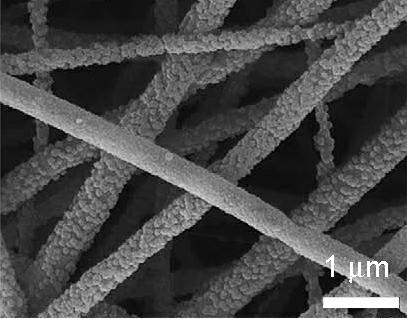Method for in-situ polymerizing and preparing polypyrrole-coated polylactic acid electrospun composite membrane
A polypyrrole-coated lactic acid and electrospinning technology, which is used in textiles and papermaking, fiber treatment, coating, etc.
- Summary
- Abstract
- Description
- Claims
- Application Information
AI Technical Summary
Problems solved by technology
Method used
Image
Examples
Embodiment 1
[0016] 0.008 mole of pyrrole was dissolved in 1 liter of deionized water to obtain a 0.008 mole / liter pyrrole solution; 0.008 mole of sodium benzenesulfonate was dissolved in 1 liter of deionized water to obtain a 0.008 mole / liter sodium benzenesulfonate solution; 0.02 mole of ferric chloride is dissolved in 1 liter of deionized water to obtain 0.02 mol / liter of ferric chloride solution; pyrrole solution and sodium benzenesulfonate solution are mixed according to a volume ratio of 5: 5, and 0.016 mole / liter of pyrrole and sodium benzenesulfonate mixed solution; put a 20 × 20 square mm homemade polylactic acid electrospun membrane into 2 ml of pyrrole and sodium benzenesulfonate mixed solution, at 1 ~ 4 o After soaking for 1 hour at C, add 2 milliliters of ferric chloride solution; o C for 12 hours; take out the electrospun membrane, and dry it at room temperature for 24 hours to obtain a polypyrrole-coated polylactic acid electrospun composite membrane. The average fiber diam...
Embodiment 2
[0018] 0.008 mole of pyrrole was dissolved in 1 liter of deionized water to obtain a 0.008 mole / liter pyrrole solution; 0.008 mole of sodium benzenesulfonate was dissolved in 1 liter of deionized water to obtain a 0.008 mole / liter sodium benzenesulfonate solution; 0.02 mole of ferric chloride is dissolved in 1 liter of deionized water to obtain 0.02 mol / liter of ferric chloride solution; pyrrole solution and sodium benzenesulfonate solution are mixed according to the volume ratio of 6:4, and 0.016 mole / liter of pyrrole and sodium benzenesulfonate mixed solution; put a 20 × 20 square mm homemade polylactic acid electrospun membrane into 2 ml of pyrrole and sodium benzenesulfonate mixed solution, at 1 ~ 4 o After soaking for 1 hour at C, add 2 milliliters of ferric chloride solution; o C for 24 hours; take out the electrospun membrane, and dry it at room temperature for 24 hours to obtain a polypyrrole-coated polylactic acid electrospun composite membrane. The average fiber dia...
Embodiment 3
[0020] 0.008 mole of pyrrole was dissolved in 1 liter of deionized water to obtain a 0.008 mole / liter pyrrole solution; 0.008 mole of sodium benzenesulfonate was dissolved in 1 liter of deionized water to obtain a 0.008 mole / liter sodium benzenesulfonate solution; 0.02 mole of ferric chloride is dissolved in 1 liter of deionized water to obtain 0.02 mol / liter of ferric chloride solution; pyrrole solution and sodium benzenesulfonate solution are mixed according to the volume ratio of 4: 6, and 0.016 mole / liter of pyrrole and sodium benzenesulfonate mixed solution; put a 20 × 20 square mm homemade polylactic acid electrospun membrane into 2 ml of pyrrole and sodium benzenesulfonate mixed solution, at 1 ~ 4 o After soaking for 1 hour at C, add 2 milliliters of ferric chloride solution; o C for 36 hours; take out the electrospun membrane, and dry it at room temperature for 24 hours to obtain a polypyrrole-coated polylactic acid electrospun composite membrane. The average fiber di...
PUM
| Property | Measurement | Unit |
|---|---|---|
| The average diameter | aaaaa | aaaaa |
| The average diameter | aaaaa | aaaaa |
| The average diameter | aaaaa | aaaaa |
Abstract
Description
Claims
Application Information
 Login to View More
Login to View More - R&D
- Intellectual Property
- Life Sciences
- Materials
- Tech Scout
- Unparalleled Data Quality
- Higher Quality Content
- 60% Fewer Hallucinations
Browse by: Latest US Patents, China's latest patents, Technical Efficacy Thesaurus, Application Domain, Technology Topic, Popular Technical Reports.
© 2025 PatSnap. All rights reserved.Legal|Privacy policy|Modern Slavery Act Transparency Statement|Sitemap|About US| Contact US: help@patsnap.com

